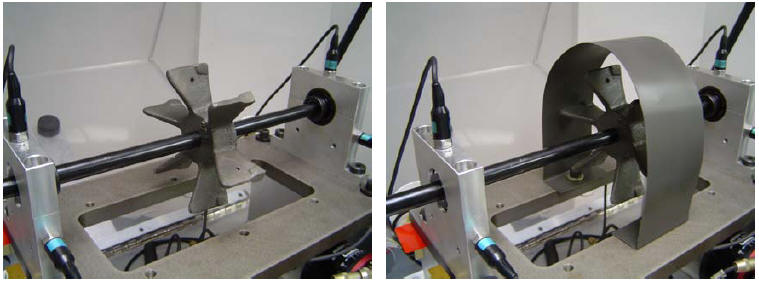Vibration Signal Analysis of Fan Rotors
Fei Xie, Zhuang Li & Suri GaneriwalaSpectraQuest Inc., 8227 Hermitage Road, Richmond, VA 23228
Published: May, 01 2007
Abstract
A fan rotor system can generate a large amplitude blade-passing frequency (BPF) component if the gap between rotating fans and stationary diffusers is not equal. A series of experiments were conducted in this study using SpectraQuest's Machinery Fault SimulatorTM (MFS) to observe the behavioral changes of the BPF and its harmonics before and after installing an obstruction nearby an axial fan and a shroud around a paddle fan. The results show that the obstruction had an obvious and consistent effect on the 1BPF and 2BPF components for the axial fan rotor system. However, for the two paddle fans tested, the shroud does not have a large effect on the 1BPF, 2BPF behavioral changes.
Introduction
During the operation of fluid turbo-machinery, such as pumps, fans or turbines, fluid dynamic perturbations are produced and can lead to vibration and noise emission. Typical fluid-dynamic excitations in such machine are generally associated with pure-tone (rotation frequency, blade-passing frequency) and broadband frequency components. The rotation frequency is due to small misalignments, unbalance or manufacturing imperfections of the impeller. The broadband phenomena are usually caused by flow turbulence and cavitation. In some cases, excitation at the blade passing frequency is dominant. This study will focus on the issues about the fan rotors and the blade passing frequency.
In this study, a series of tests were conducted using the SpectraQuest's MFS and fan kit to observe the changes of the 1BPF and 2BPF components, with and without a discharge obstruction and shroud. The running speeds were 1000 rpm, 2000 rpm and 3000 rpm.
The fan kit of the SpectraQuest MFS contains:
One sheet metal shroud
One six-blade fan
One ten-blade fan
One 12-blade axial fan
One axial fan blade obstruction
All experimental data were collected and analyzed by SpectraQuest's VibraQuest system. The VibraQuest system contains portable multi-channel data acquisition front-end, and powerful analysis functions. For each kind of fan test, the results before and after installing the obstruction/ shroud have been compared using the Comparison Panel of the VibraQuest system.

Fig 1: Before and after installing the shroud in the 6-blade paddle fan test

Fig 2: Comparison of spectra for 12-blade axial fan tests running at 3000 rpm before and after installing the obstruction





